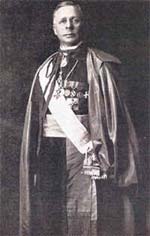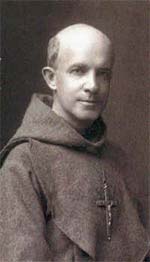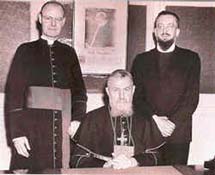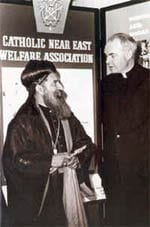Our History
I Early Years
During the years immediately following World War I, the Holy Fathers, Pope Benedict XV and Pope Pius XI, made it their mission to do all that they could to bring material and spiritual assistance to the countries and peoples sorely tried by years of war. They were supported in this great work of charity by the generosity of the faithful of the whole world and in particular by the Catholics of the United States of America. The Holy See’s appeals for aid, especially in the years 1921-1923 for the relief of famine victims in Russia, were wholeheartedly and generously responded to by the American people, and various American associations were organized to assist the needy in Russia and other regions of the Near East.
Among these organizations was “The Catholic Near East Welfare Association,” a charitable group founded in 1924 by a dynamic priest, Msgr. Richard Barry-Doyle, and Atonement Friar Paul Wattson, a former Episcopal priest dedicated to the cause of Christian unity. An Irish chaplain serving British troops during World War I, Msgr. Barry-Doyle arrived in New York at the behest of Father Paul, who enlisted the priest to raise funds for the humanitarian activities of Greek Catholic Bishop George Calavassy, the apostolic exarch in Constantinople.
The other, the “Catholic Union,” legally incorporated in the State of New York on 5 January 1925, was a branch of the “Catholica Unio,” organized to work for the reunion of the Ukrainian, Romanian, Bulgarian and, later, all the Orthodox churches with Rome. Subtitled “A Society for the Propagation of the Faith in the Near East,” the Catholic Union’s ambition was to become a worldwide organization for the support of the Oriental Congregation in much the same way as the Society for the Propagation of the Faith supported the works of the Congregation for the Propaganda Fide.
Part of its mission was “to establish and to maintain the Roman Catholic missions in Eastern Europe” and “to create and sustain a friendly interest in the religious and moral life of the peoples of Eastern Europe.” Soon afterward it was entitled “A Society for the Reunion with the Holy Church of the Separated Brethren of the Near East Incorporated.”
These two similar yet diverse entities each had its own ecclesiastical and lay advocates and supporters — “The Catholic Near East Welfare Association” advocating the cause of the Greeks and the “Catholic Union” increasingly concerned with the plight of the Russians. However, both variously described themselves as concerned for humanitarian assistance, missionary activity and the promotion of church unity.








Establishment
On 11 March 1926, Pope Pius XI decided to unite permanently into one organization and under one administration all the American Catholic associations working for assistance to Russia and other areas of the Near East and in general working for the same goals as the Sacred Congregation for the Oriental Church and the Pontifical Commission for Russia. This new pontifical organization was to be called the “Catholic Near East Welfare Association” (CNEWA). It was placed under the immediate direction of the archbishop of New York, and he was invited to form a governing body selected from the American hierarchy. The funds raised by the new association were to be placed directly at the disposition of the Holy Father, who would disburse them in response to the requests for assistance coming to him from all over the world or recommended to him by CNEWA itself.
By the mandate of the Holy See, the purposes of “The Catholic Near East Welfare Association” and the “Catholic Union” were to be included in the new association.
Pius XI commended the new association and his dispositions for it to the hierarchy of the United States. On 15 September 1926, in keeping with the wishes of the Holy Father and on the initiative of the Archbishop of New York, the bishops of the United States at their annual meeting expressed their full approval and adoption of the pope’s plan and declared that CNEWA would be their sole instrumentality authorized to solicit funds for Catholic interests in Russia and the Near East.
Initial organization and operations
CNEWA began to grow very much in accordance with the experiences and vision of its first president, Jesuit Father Edmund A. Walsh. Father Walsh, who had previously headed a special “Papal Relief Mission to Russia,” identified CNEWA as “A Society in Aid of Catholic Interests in Russia and the Near East” and saw it primarily as a papal relief agency.
Following the ratification by the U.S. bishops of the Holy See’s wishes, the Board of Directors of CNEWA agreed to continue to use the original civil charter and to organize its activities into six departments: Greece and the Balkans, General Relief in Russia and Asia Minor, Religious Welfare (to assume the work of the Catholic Union), Education and Student Exchange, Domestic Interests Affecting the Oriental Church in America, and Business Administration.
Subsequently, by the mandate or with the approval of the pope, CNEWA made grants of assistance for a wide variety of charitable works such as the relief of flood victims in Louisiana, the evacuation of Russian refugees from Constantinople, and medical and relief assistance for earthquake victims in Puerto Rico.
Father Walsh insisted that “the wish of the Holy Father is rather to form a permanent society somewhat like the International Red Cross or the American Near East Relief. It will be a centralized Catholic distributing agency which can materially assist the Holy See to meet the daily increasing demands made on the Holy Father for assistance in humanitarian works, in the field of education, and in social welfare work all over the world, as well as in distinctly religious and missionary activities.”
On 30 July 1927, Pius XI wrote to Father Walsh to express his gratitude to American Catholics for their generosity and his satisfaction that CNEWA was now constituted on a permanent basis as a pontifical organization. The next year, on 23 October 1928, the pope sent an autographed letter to the bishops of the United States praising the work of both the Society for the Propagation of the Faith and of CNEWA, expressing his appreciation for the funds raised and transmitted to him by both of the organizations, and distinguishing their respective roles.
Reorganization and clarification of mission
Father Walsh’s vision for CNEWA, however, was not universally accepted. By 1929 there was a strong reaffirmation on the part of the Holy See that the new organization was to respond to the spiritual and material needs of the East. It also made it clear that its mission was to be clearly distinguished from that of the Society for the Propagation of the Faith.
Better to clarify the competencies of the two societies and to establish a closer relationship between activities in favor of the home and foreign missions and those in favor of the spiritual needs of the missions and apostolate of the Near East and Russia, on 28 June 1930, Pope Pius XI established new regulations for these activities and for these two American organizations promoting them. He entrusted their implementation to the Cardinal Prefect of the Sacred Congregation for the Propagation of the Faith and the Cardinal Secretary of the Sacred Congregation for the Oriental Church, in conjunction with the American hierarchy.
The next year the Holy Father sent Msgr. Amleto G. Cicognani, the Assessor of the Sacred Congregation for the Oriental Church, to the United States as his personal representative to convey his dispositions for CNEWA and to see to their implementation. On 6 June 1931, a special meeting of CNEWA’s Board of Directors was held in New York City for the purpose of reorganizing CNEWA in accordance with the directives of the Holy Father. At that meeting, the archbishop of New York was elected its president and treasurer, and CNEWA was placed entirely under hierarchical control.
The satisfaction of Pope Pius XI with these new arrangements was communicated to the archbishop of New York and to the cardinal prefect of the Sacred Congregation for the Oriental Church. The pope also made some further dispositions for CNEWA. They included the provision that it was to remain under the presidency of the cardinal archbishop of New York, a charge to the Sacred Congregation for the Oriental Church to furnish information to the secretary of CNEWA about the church in the Orient, a mandate to CNEWA also to concern itself with public relations and the education of the faithful about the condition of the communities of the East, and some additional instructions about the apportionment and handling of the Mission Sunday collection.
From this point forward, the role and proper activities of CNEWA were clear. The renewed satisfaction of the Holy See was communicated to the archbishop of New York as president of CNEWA, and the funds obtained from the Mission Sunday collection or procured directly by CNEWA itself, such as Mass stipends, educational burses, designated gifts and other special contributions, were regularly forwarded to the Sacred Congregation for the Oriental Church or to other institutions as requested by the Holy Father or by the congregation.
CNEWA continued to operate under its Pennsylvania civil charter until 14 December 1942, when it was reincorporated according to the laws of the State of New York.
This reorganization of CNEWA and clarification of its mission still underlies the structure of CNEWA today.
Later Development of CNEWA
In support of the Eastern Catholic churches
Following the intervention of the Oriental Congregation in 1931 and the clarification of the nature and mission of CNEWA, the organization began to concentrate its efforts on supporting the Eastern Catholic churches and the persons and institutions under the jurisdiction of the Oriental Congregation.
Initially, the staff of the congregation was intimately involved in the work of CNEWA. An “Ufficio CNEWA” was created within the congregation to coordinate the transmission of requests for funding and the disbursement of funds to and from CNEWA’s administrative center in New York City. The names of each donor to the work of CNEWA and the amounts of their contributions were sent to the Oriental Congregation, and the prefect of the congregation himself would send a letter of acknowledgment and thanks to each.
As the years passed, since CNEWA was heavily involved in supporting institutions, especially the seminaries, novitiates and orphanages of the Eastern Catholic churches, a sponsorship program was devised, with great success, to interest individuals in their support and to raise money for them. This, of course, tremendously increased the amount of correspondence and record keeping. The Oriental Congregation decided to leave the acknowledgment of donor gifts to CNEWA’s general secretary in New York, while the disbursement of funds in support of institutions and projects continued to be made by the congregation itself.
Emergency relief and social development
On 18 June 1949, out of his concern for the plight of Palestinian refugees in the aftermath of the Israeli-Arab struggle of the previous year, Pope Pius XII decided that the work of humanitarian and charitable assistance of the Holy See for Palestine and all those afflicted by war there was to be consolidated and formalized by the establishment of a special “Pontifical Mission for Palestine.” Its direction was entrusted to the secretary of CNEWA, and it was mandated to conduct its activities in Palestine and in the neighboring countries of the Middle East so as to make available to every exiled or needy Palestinian the charity of the pope and of all Catholics of the world.
Because it was only a few years after the conclusion of World War II and at that time the Catholic Church in the United States was in a better condition to support charitable aid than the church in Europe, the Holy See especially sought the help of U.S. Catholic agencies. CNEWA was asked to assist the Pontifical Mission for Palestine in accomplishing its work. Since the mission lacked civil status in the United States, CNEWA made appeals for its work and collected funds for it. CNEWA also provided the administrative and financial support necessary for the Pontifical Mission’s operations in addition to most of the means of assistance for the persons it served.
Although originally envisaged as a short-term, emergency program, the work of the Pontifical Mission necessarily continued in the uncertain and troubled arena of the Middle East. By 1967, it had evolved from providing emergency assistance for refugees to assisting an entire population living under martial law with few or weak social institutions. With the outbreak of the Lebanese civil war, the beneficiaries of the work of the Pontifical Mission began to be not only Palestinians but also Lebanese. With the Gulf War, its work extended to Iraqi refugees. By the time of its 50th anniversary in 1999, it was recognized as the Holy See’s overall development agency for the Middle East.
While the Pontifical Mission for Palestine is canonically distinct from CNEWA, in practice both organizations are united under one administration. The Pontifical Mission, in addition to its proper activities of emergency aid and social development, also administers programs of CNEWA. In effect, it functions as the Middle East operating agency of CNEWA.
On the occasion of the 25th anniversary of the Catholic Near East Welfare Association, Pope Pius XII, in an autographed letter to its president, Francis Cardinal Spellman, congratulated CNEWA for its work of safeguarding and fostering the faith among the Catholics of the Oriental rites and for its magnanimous cooperation with the Pontifical Mission. The Holy Father expressed his continuous need for assistance for all the peoples of the Near East and Eastern Catholics and his hopes and prayers for the expansion of the membership and work of CNEWA.
New structures for local program oversight
To assist the transmissions of funds for CNEWA’s needy child sponsorship program in Ethiopia, the “Ufficio CNEWA” within the Congregation for the Eastern Churches engaged the services of local staff in Addis Ababa. Meanwhile, the New York office of CNEWA was utilizing the part-time services of local Ethiopian staff for project oversight. As responsibility for the disbursement of needy child sponsorship funds moved from the “Ufficio CNEWA” and the Congregation in Rome to CNEWA’s administrative headquarters in New York, it was decided to organize in 1986 a regional office in Addis Ababa to assume responsibility for all programmatic disbursements, whether subsidies to institutions or grants for programs and projects.
While D. Simon Cardinal Lourdusamy was prefect of the Congregation for the Eastern Churches, responsibility for needy child sponsorship program disbursements and then seminarian and novice sponsorship program disbursements was transferred to the New York office of CNEWA.
When Achille Cardinal Silvestrini became the prefect of the congregation, he encouraged CNEWA to manage the transmissions of all funds, including grants for projects and programs, directly from New York, rather than through the “Ufficio CNEWA” within the Congregation. Later, on 11 June 1994, these procedures were formalized and, in response to Cardinal Silvestrini’s request, the “Ufficio CNEWA” was removed from the congregation and joined to the existing Pontifical Mission office in Rome. The changes were considered ad experimentum for a period of five years. In 1999, they were deemed satisfactory and made permanent.
The same year, another regional office was established in Ernakulam to ensure better oversight of the extensive program of CNEWA in India, and responsibility for much of the operational detail concerned with institutional subsidies and the agency’s three person-to-person sponsorship programs was transferred to the new office.
A characteristic of all of these offices of CNEWA is that they are available to assist the dicasteries of the Holy See, especially the Congregation for the Eastern Churches, as well as Catholic donor agencies in assessment of local applications for subsidies or grants, in the administration of programmatic disbursements and in supplying appropriate and supporting reports.
The innovative programs of personal sponsorship of the education and formation of individual seminarians and novices and of the care of individual orphaned or needy children developed by CNEWA had great success. Also the membership of CNEWA gradually expanded to include Catholics in Canada and, to a lesser extent, Mexico and other countries, to the point that CNEWA became the principal animator and collector in North America of assistance for the Near East.
Ecumenical and interreligious activities
The restructuring of CNEWA initiated in 1985 under the presidency of John Cardinal O’Connor not only led to a major expansion of programmatic activities and the development of additional regional offices, but to a renewed and greater emphasis on the ecumenical aspect of CNEWA’s foundational mission. Although the primary beneficiaries of CNEWA’s funding activities continued to be the Eastern Catholic churches and their institutions and programs, increasingly support began to be given to the Orthodox and other churches in the countries within CNEWA’s area of service.
This was a conscious and deliberate return to CNEWA’s original mandate, inherited from the Catholic Union, to work for the union of the Orthodox churches with the Holy See and to make CNEWA active in the “dialogue of charity.” By extension, some deployment of CNEWA’s resources also began to be made to assist Muslims and other non-Christians through their participation in CNEWA’s works of charity.
Expansion of CNEWA
With the strong encouragement of not only its own episcopal Board of Trustees but also the prefects of the Congregation for the Eastern Churches, first Achille Cardinal Silvestrini and then Ignace Moussa I Cardinal Daoud, plans were developed for the creation of branch, national offices of CNEWA to raise public awareness of the Eastern churches and the countries in which they are located and to solicit funds for their subvention.
Under the leadership of Archbishop Marcel Gervais of Ottawa, “CNEWA Canada” was organized and incorporated. This prompted the separation of a distinct “CNEWA United States” and a restructuring of the governance of the central, mother organization of CNEWA.
In Canada, support and interest in CNEWA’s activities grows each year. For financial and operation reasons, however, CNEWA’s board of trustees dissolved CNEWA United States and reintegrated its functions with CNEWA effective 31 January 2013.
Mission and Goals
Catholic Near East Welfare Association, founded by the Holy Father, shares the love of Christ with the churches and peoples of the East.
CNEWA works for, through and with the Eastern Catholic churches to identify needs and implement solutions.
CNEWA connects you to your brothers and sisters in need. Together, we build up the church, affirm human dignity, alleviate poverty, encourage dialogue — and inspire hope.
Structure
CNEWA, although remaining one unified institution in accordance with canon law and the directives of the Holy See, utilizes as many civil corporate structures as may be necessary to the fulfillment of its mission.
Governance
Board of Trustees. The governing body of CNEWA is a board of trustees. The archbishop of New York is a trustee ex officio; the remaining trustees are elected for terms of four years by the board itself, originally from among the cardinals, archbishops and bishops of the United States and now also from the hierarchies of other countries where national branches of CNEWA have been established. The trustees meet at least once every year on a date fixed by the archbishop of New York.
Chair. The archbishop of New York is ex officio the chair of CNEWA and of the board of trustees. He is responsible for the overall supervision and direction of CNEWA.
Vice-Chair. The vice-chair of CNEWA is elected by the board of trustees from among its members at its annual meeting for a term of one year. In the event of the absence, disability or death of the chair, the vice-chair presides at all meetings of the board of trustees and in all other respects performs the duties of the chair.
Treasurer. The archbishop of New York is ex officio the treasurer of CNEWA. He is responsible for the overall management of the business affairs and assets of CNEWA.
Secretary. The secretary of CNEWA is nominated by the chair and elected by the board of trustees at its annual meeting to serve for such term as the board may determine. His election is confirmed by the Holy See. The secretary is the chief executive officer and president of CNEWA. He is responsible for directing it, under the supervision of the chair, in support of the mission, plans and policies approved by the board of trustees.
National Secretaries. In those countries where national branches of CNEWA have been created, a national secretary is nominated by the president and elected by the board of directors of the national branch at its annual meeting to serve for such term as the president may propose and the board may determine. Each national secretary is the chief executive officer of the national branch of CNEWA. He is responsible for supervising the affairs and operations of the national branch in cooperation with the president.
Other officials. Other officers are appointed by the president to serve for such term as he may designate.
Headquarters
CNEWA, as a corporation incorporated under the religious corporations law of the State of New York State, maintains its principal office in that state. As a public association of the Christian faithful placed under the direction and presidency of the archbishop of New York by the Holy See, CNEWA maintains its central office Rome and considers its New York office as its administrative headquarters.
Membership
Any person who approves of the purposes of CNEWA and who agrees to submit to its rules and regulations is eligible for membership in CNEWA. Membership consists of active members and passive members as regulated by the board of trustees.
The active members of CNEWA are the trustees themselves. The passive members are the voluntary donors and benefactors of CNEWA.
Policies
The policies of CNEWA are determined by its board of trustees. CNEWA conducts its activities in accordance with the dispositions of the Holy Father and the policies of the Holy See.
